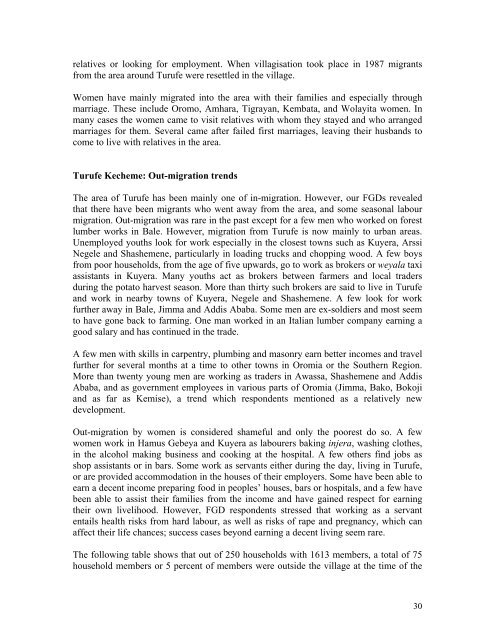Migration and Rural-Urban Linkages in Ethiopia
Migration and Rural-Urban Linkages in Ethiopia - Ethiopian Review
Migration and Rural-Urban Linkages in Ethiopia - Ethiopian Review
Create successful ePaper yourself
Turn your PDF publications into a flip-book with our unique Google optimized e-Paper software.
elatives or look<strong>in</strong>g for employment. When villagisation took place <strong>in</strong> 1987 migrantsfrom the area around Turufe were resettled <strong>in</strong> the village.Women have ma<strong>in</strong>ly migrated <strong>in</strong>to the area with their families <strong>and</strong> especially throughmarriage. These <strong>in</strong>clude Oromo, Amhara, Tigrayan, Kembata, <strong>and</strong> Wolayita women. Inmany cases the women came to visit relatives with whom they stayed <strong>and</strong> who arrangedmarriages for them. Several came after failed first marriages, leav<strong>in</strong>g their husb<strong>and</strong>s tocome to live with relatives <strong>in</strong> the area.Turufe Kecheme: Out-migration trendsThe area of Turufe has been ma<strong>in</strong>ly one of <strong>in</strong>-migration. However, our FGDs revealedthat there have been migrants who went away from the area, <strong>and</strong> some seasonal labourmigration. Out-migration was rare <strong>in</strong> the past except for a few men who worked on forestlumber works <strong>in</strong> Bale. However, migration from Turufe is now ma<strong>in</strong>ly to urban areas.Unemployed youths look for work especially <strong>in</strong> the closest towns such as Kuyera, ArssiNegele <strong>and</strong> Shashemene, particularly <strong>in</strong> load<strong>in</strong>g trucks <strong>and</strong> chopp<strong>in</strong>g wood. A few boysfrom poor households, from the age of five upwards, go to work as brokers or weyala taxiassistants <strong>in</strong> Kuyera. Many youths act as brokers between farmers <strong>and</strong> local tradersdur<strong>in</strong>g the potato harvest season. More than thirty such brokers are said to live <strong>in</strong> Turufe<strong>and</strong> work <strong>in</strong> nearby towns of Kuyera, Negele <strong>and</strong> Shashemene. A few look for workfurther away <strong>in</strong> Bale, Jimma <strong>and</strong> Addis Ababa. Some men are ex-soldiers <strong>and</strong> most seemto have gone back to farm<strong>in</strong>g. One man worked <strong>in</strong> an Italian lumber company earn<strong>in</strong>g agood salary <strong>and</strong> has cont<strong>in</strong>ued <strong>in</strong> the trade.A few men with skills <strong>in</strong> carpentry, plumb<strong>in</strong>g <strong>and</strong> masonry earn better <strong>in</strong>comes <strong>and</strong> travelfurther for several months at a time to other towns <strong>in</strong> Oromia or the Southern Region.More than twenty young men are work<strong>in</strong>g as traders <strong>in</strong> Awassa, Shashemene <strong>and</strong> AddisAbaba, <strong>and</strong> as government employees <strong>in</strong> various parts of Oromia (Jimma, Bako, Bokoji<strong>and</strong> as far as Kemise), a trend which respondents mentioned as a relatively newdevelopment.Out-migration by women is considered shameful <strong>and</strong> only the poorest do so. A fewwomen work <strong>in</strong> Hamus Gebeya <strong>and</strong> Kuyera as labourers bak<strong>in</strong>g <strong>in</strong>jera, wash<strong>in</strong>g clothes,<strong>in</strong> the alcohol mak<strong>in</strong>g bus<strong>in</strong>ess <strong>and</strong> cook<strong>in</strong>g at the hospital. A few others f<strong>in</strong>d jobs asshop assistants or <strong>in</strong> bars. Some work as servants either dur<strong>in</strong>g the day, liv<strong>in</strong>g <strong>in</strong> Turufe,or are provided accommodation <strong>in</strong> the houses of their employers. Some have been able toearn a decent <strong>in</strong>come prepar<strong>in</strong>g food <strong>in</strong> peoples’ houses, bars or hospitals, <strong>and</strong> a few havebeen able to assist their families from the <strong>in</strong>come <strong>and</strong> have ga<strong>in</strong>ed respect for earn<strong>in</strong>gtheir own livelihood. However, FGD respondents stressed that work<strong>in</strong>g as a servantentails health risks from hard labour, as well as risks of rape <strong>and</strong> pregnancy, which canaffect their life chances; success cases beyond earn<strong>in</strong>g a decent liv<strong>in</strong>g seem rare.The follow<strong>in</strong>g table shows that out of 250 households with 1613 members, a total of 75household members or 5 percent of members were outside the village at the time of the30




![to read the full report [pdf, Amharic] - Ethiopian Review](https://img.yumpu.com/52737829/1/190x245/to-read-the-full-report-pdf-amharic-ethiopian-review.jpg?quality=85)











